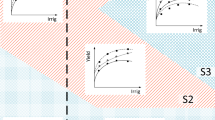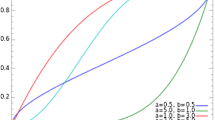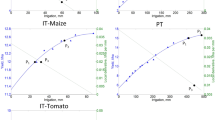Abstract
Deficit irrigation has been suggested as a way to increase system benefits, at the cost of individual benefits, by decreasing the crop water allocation and increasing the total irrigated land. Deterministic methods are common for determining optimal irrigation schedules with deficit irrigation because considering the inherent uncertainty in crop water demands while including the lower and upper bounds on soil moisture availability is a hard problem. To deal with this, a constraint state formulation for stochastic control of the weekly deficit irrigation strategy is proposed. This stochastic formulation is based on the first and second moment analysis of the stochastic soil moisture state variable, considering soil moisture as bounded between a maximum value and a minimum value. As a result, an optimal deficit irrigation scheduling is determined using this explicit stochastic model that does not require discretization of system variables. According to the results, if irrigation strategy is based on deterministic predictions, achievement of high, long-term expected relative net benefits by decreased crop water allocation and increased irrigated land may have a higher failure probability.







Similar content being viewed by others
References
Chen JY, Tang CY, Sakura Y, Kondoh A, Shen YJ, Song XF (2004) Measurement and analysis of the redistribution of soil moisture and solutes in a maize field in the lower reaches of the Yellow River. Hydrol Process 18:2263–2273
Cox DR, Isham V (1968) The virtual waiting-time and related processes. Adv Appl Probab 18:558–573
Doorenbos J, Kassam AH (1979) Yield response to water. Irrigation and drainage paper, No. 33. FAO, United Nations, Rome
English MJ (1981) The uncertainty of crop models in irrigation optimization. Trans ASAE 24(4):917–921
English M, James L, Chen CF (1990) Deficit irrigation II: observation in Columbia Basin. J Irrig Drain Eng 116:413–426
Fletcher S, Ponnambalam K (1998) A constrained state formulation for the stochastic control of multi-reservoir systems. Water Resour Res 34(2):257–270
Ganji A, Ponnambalam K, Khalili D, Karamouz M (2006) Grain yield reliability analysis with crop water demand uncertainity. Stoch Env Res Risk Assess (in press). DOI: 10.1007/s00477-005-0020-7
Ghahraman B, Sepaskhah AR (1997) Use of a water deficit sensitivity index for partial irrigation scheduling of wheat and barley. Irrig Sci 18:11–16
Hill WR, Hanks RJ, Wright JL (1982) Crop yields model adapted to irrigation scheduling programs. Research report 99. Utah Agricultural Experimental Station, Utah University, Logan
Jensen ME (1986) Water consumption by agricultural plants. In: Kozlowski TT (ed) Water deficit and plant growth. Academic, New York, pp 1–22
Kipkorir EC, Raes D (2002) Transformation of yield response factor into Jensen’s sensitivity index. Irrig Drain Syst 16:47–52
Kuo SF, Liu CW (2003) Simulation and optimization model for irrigation planning and management. Hydrol Process 17:3141–3159
Laio F, Porporato A, Fernandez-Illescas CP, Rodriguez-Iturbe I (2001) Plants in water-controlled ecosystems: active role in hydrological processes and response to water stress IV. Discussion of real cases. Adv Water Res 24(7):745–762
Mannocchi F, Mecarelli P (1994) Optimization analysis of deficit irrigation systems. J Irrig Drain Eng 120:484–502
Martin DL, Stegman EC, Fereres E (1990) Irrigation scheduling principle. In: Hoffman GJ, Howell TA, Solomon KH (eds) Management of farm irrigation system. ASAE Monograph, pp 149–175
Milly PCD (1993) An analytic solution of the stochastic storage problem applicable to soil water. Water Resour Res 29(11):3755–3758
Nairizi S, Rydzewski JR (1976) Effects of dated soil moisture stress on crop yields. Exp Agric 13:51–59
Paul S, Danda SN, Nagesh Kumar D (2000) Optimal irrigation: a multilevel approach. J Irrig Drain Eng 126(3):149–154
Porporato A, Laio F, Ridolfi L, Rodriguez-Iturbe I (2001) Plants in water-controlled ecosystems: active role in hydrological processes and response to water stress III. Vegetation water stress. Adv Water Res 24(7):725–744
Ramirez JA, Bras RL (1985) Conditional distribution of Neyman–Scott models for storm arrivals and their use in irrigation scheduling. Water Resour Res 21(3):317–330
Rao NH, Sarma PBS, Chander S (1990) Optimal multi crop allocation of seasonal and intra seasonal irrigation. Water Resour Res 26:551–559
Rodriguez-Iturbe I, Porporato A, Ridolfi L, Isham V, Cox D (1999) Probabilistic modelling of water balance at a point: the role of climate, soil and vegetation. Proc R Soc Lond 455:3789–3805
Sunantara J, Ramfrez J (1997) Optimal stochastic multicrop and interseasonal irrigation control. J Water Resour Plan Manage 123(1):39–48
Tsakiris GP (1982) A method for applying crop sensitivity factors in irrigation scheduling. Agric Water Manage 5:335–343
Vedula S, Nagesh Kumar D (1996) An integrated model for optimal reservoir operation for irrigation of multiple crops. Water Resour Res 32(4):1101–1108
Villalobos FG, Fereres E (1989) A simulation model for irrigation scheduling under variable rainfall. Trans ASAE 32(1):181–188
Yoo C, Kim S, Valdes JB (2005) Sensitivity of soil moisture field evolution to rainfall forcing. Hydrol Process 19:1855–1869
Zhang X, Pei D, Chen S (2004) Root growth and soil water utilization of winter wheat in the North China Plain. Hydrol Process 18:2275–2287
Author information
Authors and Affiliations
Corresponding author
Additional information
Communicated by S. Ortega-Farias
Appendix: Second-order derivation for sample terms
Appendix: Second-order derivation for sample terms
Sample term A
Consider the term
where θpwp is the relative soil moisture unavailable for plant growth or the water content at wilting point (m3/m3), (1−p) the average fraction of total available soil water that can be depleted from the root zone before moisture stress (reduction in ET) occurs and θFC the water content at field capacity. This term can be divided into three individual parts as indicated by Eq. 13:
The second-order approximation of the first two parts is calculated next and the third part is determined similarly but not shown here.
AI. Using the property of the indicator function, the first term of Eq. 13, AI, can be expressed as follows:
\(f_{{\eta}_{t}} \left(\eta_{t}\right)\) is the probability density function of the random noise term, η t ∼ N[ 0, Var(η t ) ], for the current work. \(f_{\theta_{t - 1}} \left(\theta_{t - 1}\right)\) is the density function of the soil moisture state variable in the previous period. (θ t - 1) and η t are assumed independent; thus it can be written:
which is the expectation of a function of (θ t - 1) and can be shown as
where \(f_{\eta_{t}} \left(\eta_{t}\right)\) is presented as follows:
For the current study, the integral in Eq. 16 is represented as follows:
The second-order Taylor’s series approximation of the expectation of Eq. 16 is thus given as:
AII. Using the property of the indicator function and assuming (θ t - 1) and η t are independent, the second term of Eq. 13, AII, can be expressed as follows:
which is the expectation of a function of (θ t - 1) and can be shown as:
where \(f_{\eta_{t}} \left(\eta_{t}\right)\) is presented as follows:
The expectation of Eq. 22 is thus given as
The second-order Taylor’s series approximation of the expectation of Eq. 24 is thus given as
Rights and permissions
About this article
Cite this article
Ganji, A., Ponnambalam, K., Khalili, D. et al. A new stochastic optimization model for deficit irrigation. Irrig Sci 25, 63–73 (2006). https://doi.org/10.1007/s00271-006-0035-y
Received:
Accepted:
Published:
Issue Date:
DOI: https://doi.org/10.1007/s00271-006-0035-y




